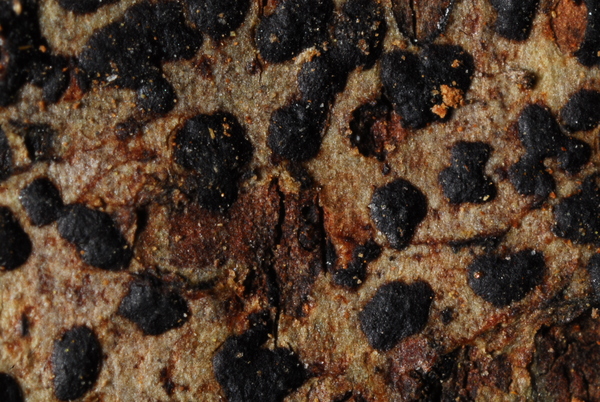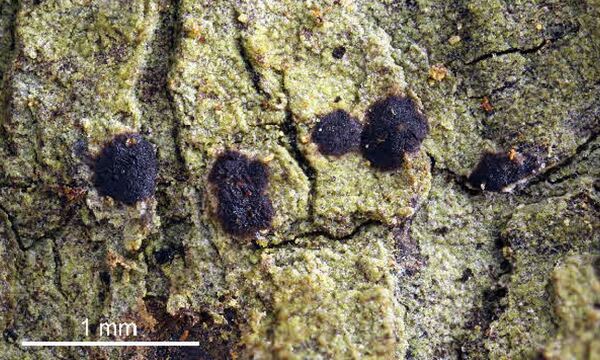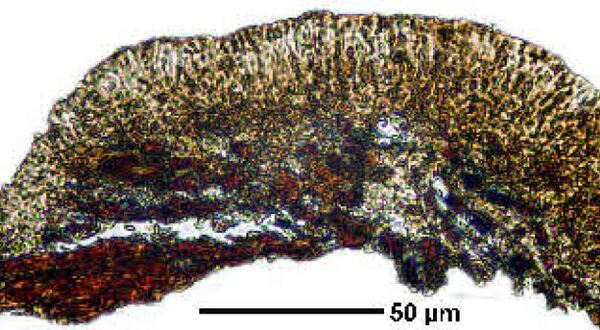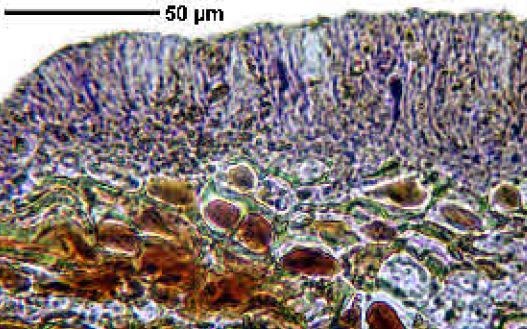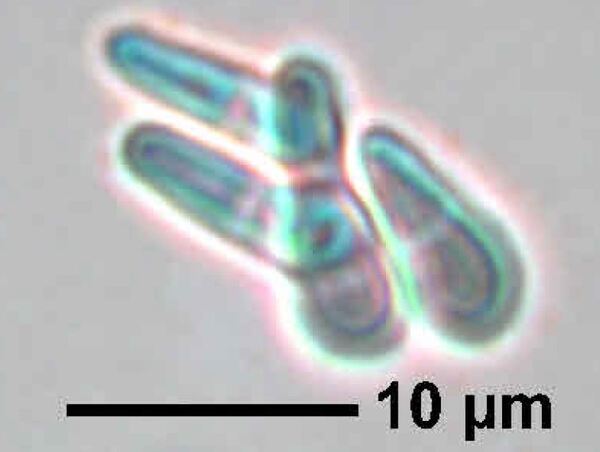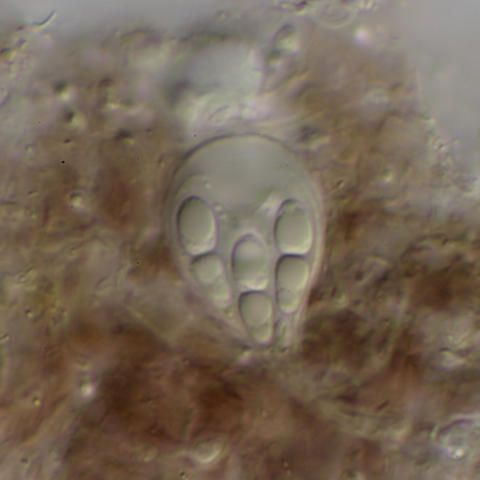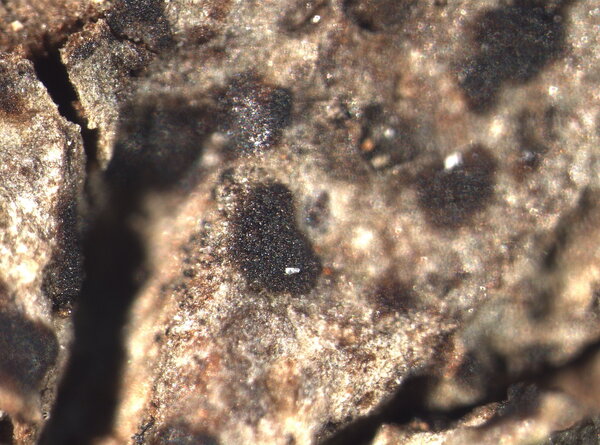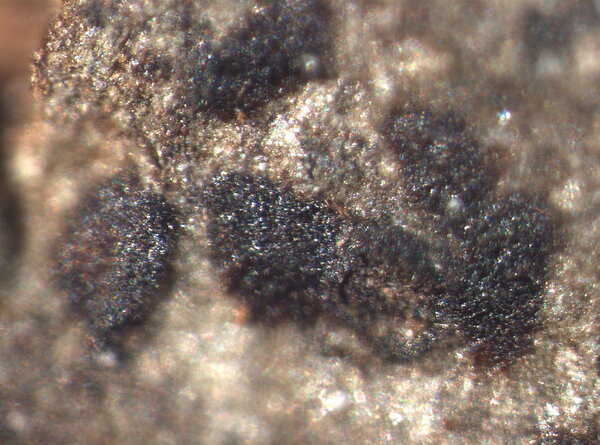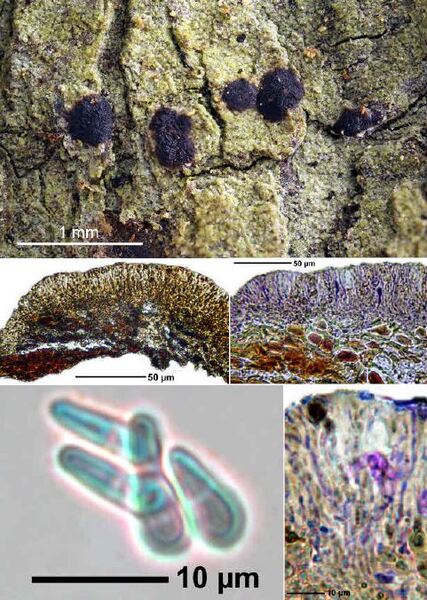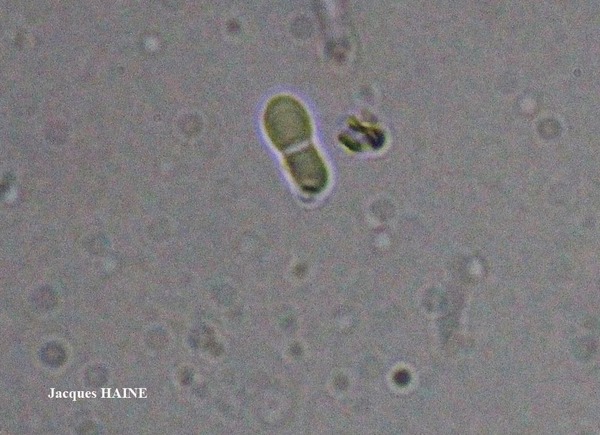Diarthonis spadicea (Leight.) Frisch, Ertz, Coppins & P.F.Cannon
in Cannon & al., Revisions of British and Irish Lichens. Vol. 1 Arthoniales: Arthoniaceae: 44, 2020. . Basionym: Arthonia spadicea Leight. - Ann. Mag. Nat. Hist., ser. 2, 13: 442, 1854.
Synonyms: Arthonia lurida Ach. non auct. ital. p.p.; Arthonia lurida var. spadicea (Leight.) Nyl.; Arthonia sublurida Anzi?; Coniangium spadiceum (Leight.) Arnold
Distribution: N - Ven (Nascimbene & Marini 2010, Nascimbene & al. 2012, 2015), TAA (Nascimbene & al. 2007b, 2022, Nascimbene 2013, Nimis & al. 2015), Lomb (Gheza & al. 2022b), Piem (Matteucci & al. 2013), Lig. C - Tosc, Laz (Ravera 2006, 2006c), Abr. S - Camp (Brunialti & al. 2010, 2013, Ravera & Brunialti 2013), Pugl (Nimis & Tretiach 1999), Bas (Nimis & Tretiach 1999), Cal (Puntillo 1996, Sérusiaux 1998, Puntillo & Puntillo 2004, 2012).
Description: Thallus crustose, mostly endosubstratic, rarely thinly episubstratic, up to 40 μm thick, not well-delimited, greenish grey to olive-coloured, the hyphae K/I-. Apothecia arthonioid, rounded, elliptical or irregular in outline, red-brown to brown-black, often slightly glossy, 0.2-1(-1.5) mm across, 50-75 μm tall, with a flat to slightly convex disc, without a distinct proper margin. Epithecium indistinct; hymenium 25-35(-40) μm high, orange-brown, K+ pale purple, I+ wine-red; paraphysoids 0.5-1(-1.5) μm thick, not swollen at apices, without a dark cap; hypothecium orange-brown, 30-40 μm high. Asci 8-spored, broadly clavate to subglobose, distinctly stipitate, semi-fissitunicate, with a large apical dome and a distinct ocular chamber, Arthonia-type. Ascospores 1-septate with slightly unequal cells, hyaline, ovoid, 7-11 x 3-4 μm. Pycnidia frequent, 80-100 μm across, brown, the wall orange- to red-brown, K+ pale purple, the pigments not dissolving. Conidia bacilliform or narrowly ellipsoid, straight or slightly curved, 3-4.5(-6) x 0.5-1 μm. Photobiont trentepohlioid. Spot tests: thallus K-, C-, KC-, P-, UV-. Chemistry: thallus without lichen substances.Note: a mainly temperate lichen found on smooth bark in humid forests (e.g. on Ilex in the southern mountains), but also on basal parts of old oaks inside humid forests. It is included in the Italian red list of epiphytic lichens as “Near-threatened” (Nascimbene & al. 2013c).
Growth form: Crustose
Substrata: bark
Photobiont: Trentepohlia
Reproductive strategy: mainly sexual
Most common in areas with a humid-warm climate (e.g. most of Tyrrenian Italy)
Commonnes-rarity: (info)
Alpine belt: absent
Subalpine belt: absent
Oromediterranean belt: absent
Montane belt: very rare
Submediterranean belt: extremely rare
Padanian area: extremely rare
Humid submediterranean belt: very rare
Humid mediterranean belt: absent
Dry mediterranean belt: absent

Predictive model
Herbarium samples
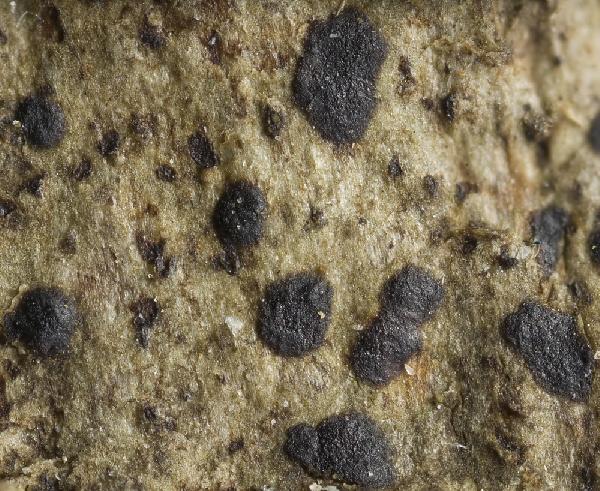
Ulrich Kirschbaum CC BY-SA 4.0 - Source: https://www.thm.de/lse/ulrich-kirschbaum/flechtenbilder
On the base of deciduous trees.Central Europe: Germany.(Coll/ident: Eichler/Cezanne).
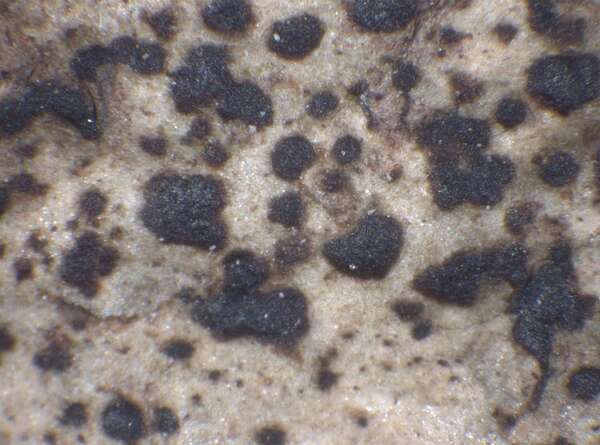

P.L. Nimis; Owner: Department of Life Sciences, University of Trieste
Herbarium: TSB (21819)
2003/03/11
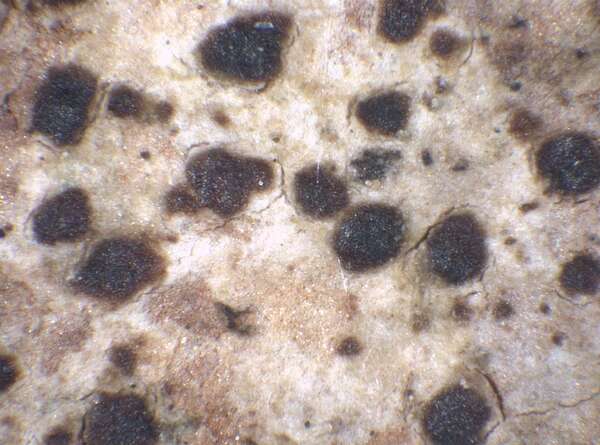

P.L. Nimis; Owner: Department of Life Sciences, University of Trieste
Herbarium: TSB (21819)
2003/03/11
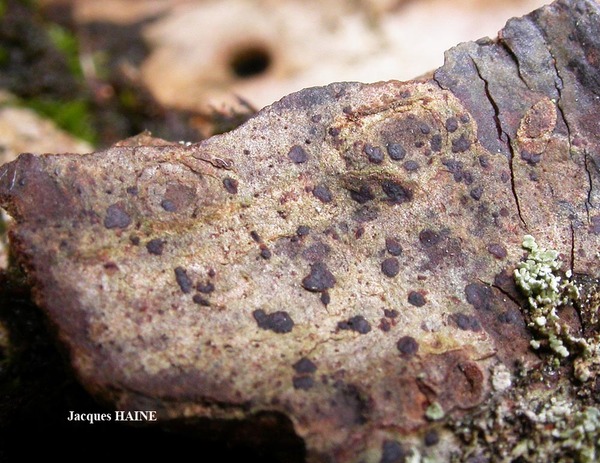
Jacques Haine - Source: http://www.lichensmaritimes.org/index.php?task=fiche&lichen=573&lang=en
France, Ardennes
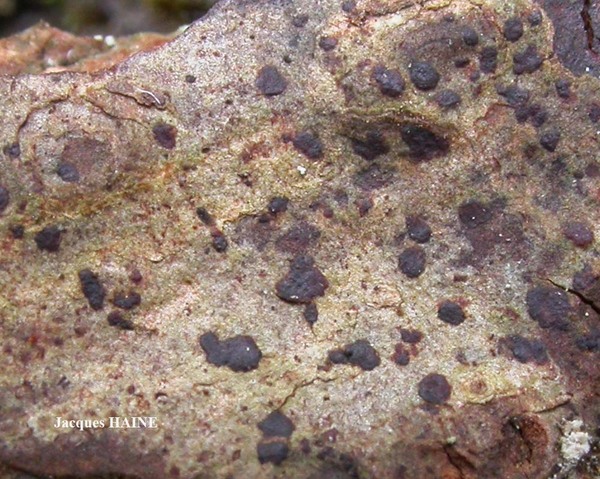
Jacques Haine - Source: http://www.lichensmaritimes.org/index.php?task=fiche&lichen=573&lang=en
France, Ardennes
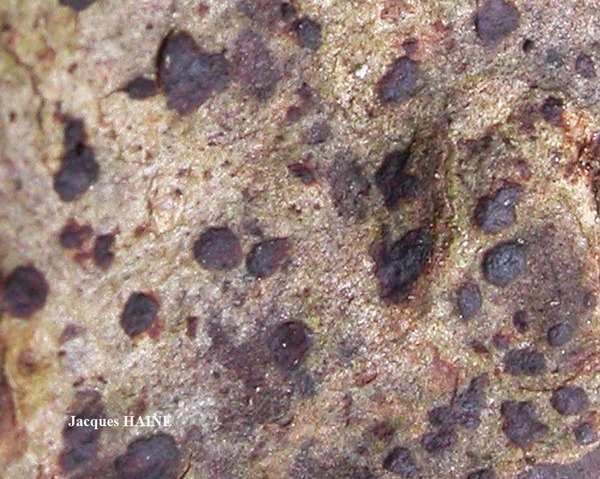
Jacques Haine - Source: http://www.lichensmaritimes.org/index.php?task=fiche&lichen=573&lang=en
France, Ardennes
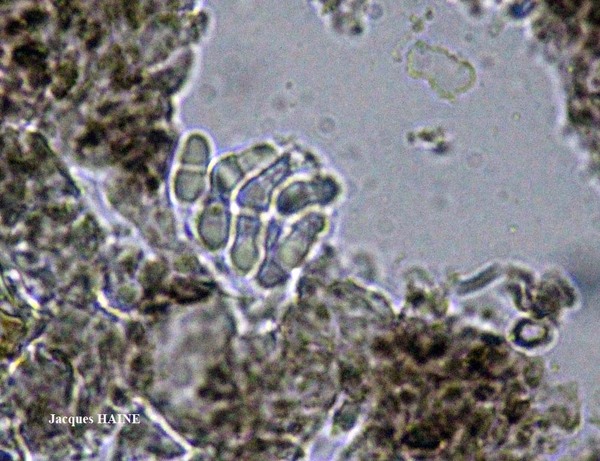
Jacques Haine - Source: http://www.lichensmaritimes.org/index.php?task=fiche&lichen=573&lang=en
France, Ardennes
Growth form: Crustose
Substrata: bark
Photobiont: Trentepohlia
Reproductive strategy: mainly sexual
Most common in areas with a humid-warm climate (e.g. most of Tyrrenian Italy)
Commonnes-rarity: (info)
Alpine belt: absent
Subalpine belt: absent
Oromediterranean belt: absent
Montane belt: very rare
Submediterranean belt: extremely rare
Padanian area: extremely rare
Humid submediterranean belt: very rare
Humid mediterranean belt: absent
Dry mediterranean belt: absent

Predictive model
| Herbarium samples |

Ulrich Kirschbaum CC BY-SA 4.0 - Source: https://www.thm.de/lse/ulrich-kirschbaum/flechtenbilder
On the base of deciduous trees.Central Europe: Germany.(Coll/ident: Eichler/Cezanne).


P.L. Nimis; Owner: Department of Life Sciences, University of Trieste
Herbarium: TSB (21819)
2003/03/11


P.L. Nimis; Owner: Department of Life Sciences, University of Trieste
Herbarium: TSB (21819)
2003/03/11

Jacques Haine - Source: http://www.lichensmaritimes.org/index.php?task=fiche&lichen=573&lang=en
France, Ardennes

Jacques Haine - Source: http://www.lichensmaritimes.org/index.php?task=fiche&lichen=573&lang=en
France, Ardennes

Jacques Haine - Source: http://www.lichensmaritimes.org/index.php?task=fiche&lichen=573&lang=en
France, Ardennes

 INDEX FUNGORUM
INDEX FUNGORUM
 GBIF
GBIF
 DOLICHENS
DOLICHENS
